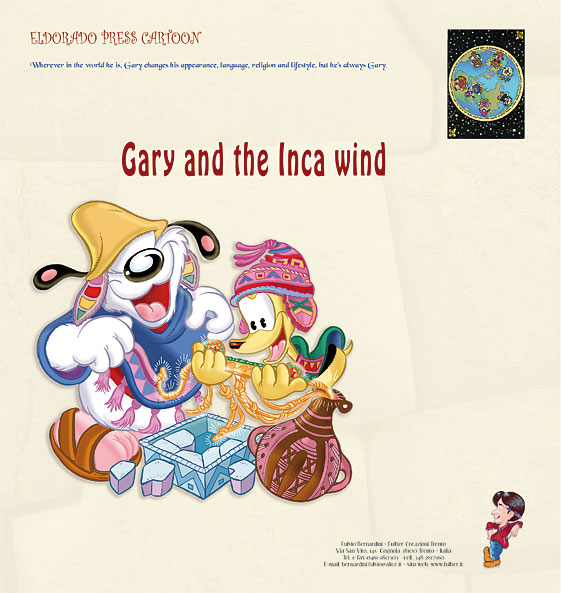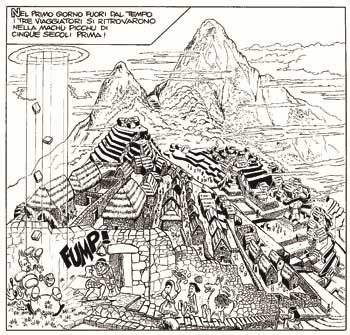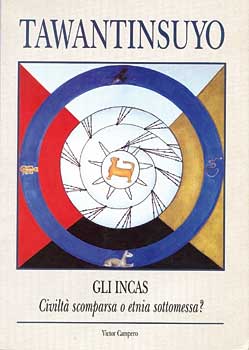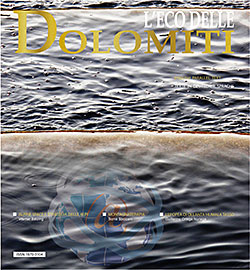
A leap back in time that catapults our canine heroes Gary and Spike and yes, oh dear, the Mephistophelean hunter of archaeological finds, Prof. Hodius Obnoxius too, to the mythical lost city of Machu Picchu of five hundred years ago (discovered in the region of Peru by Hiram Bingham in July 1911).
Technical Advisor: Victor Campero Luna for the introduction to the story and the documentation, with bibliographical references to his published work Tawantinsuyo, the Incas, lost civilisation or subject ethnic group?
Victor Campero Luna, born in Cuzco-Peru, graduated in Sociology in Lima. He has organised conferences and studies on pre-Colombian and pre-modern civilisations both in Italy and abroad.
Introduction to the story
 

The "quipus" is an ingenious alternative to writing thanks to a system of interwoven threads.
Thanks to the help of Dona Rosita, the ancient lady of the ruins of Machu Pichu and of a rare Quipu created using golden threads that conceals a secret for travelling backwards in time, Gary, Spike and Hodius end up in the "Dimora del Sol", the ancient lost city of the Incas, at the start of the Spanish invasion.  An ancient Andean prayer, if recited inside a circle, has the power of generating a "Huayra Inka" (the Inca wind) that has the power to knock down the walls of time and space. Hodius is determined to use this formidable machine for his own sinister ends in order to get his hands on a fabulous pile of gold dust, using the Quipu as a veritable map. However, no one in modern times knows of a system for deciphering the ancient manuscript and so this requires the services of a Quipucamayoc , an expert who is capable of "reading and translating" the complicated combination of knotted threads. These experts of the Inca system however, vanished centuries ago with the setting of the Empire of the Sun. Hodius overcomes this problem and by travelling back in time will find one of them to look at the golden Quipu and reveal the mystery and the coordinates for locating the precious treasure. Gary and Spike will be dragged into this adventure with the ancient Inca populations with its dramatic twists and turns and will have to take part in their odious travelling companion's heinous crimes and greed. An ancient Andean prayer, if recited inside a circle, has the power of generating a "Huayra Inka" (the Inca wind) that has the power to knock down the walls of time and space. Hodius is determined to use this formidable machine for his own sinister ends in order to get his hands on a fabulous pile of gold dust, using the Quipu as a veritable map. However, no one in modern times knows of a system for deciphering the ancient manuscript and so this requires the services of a Quipucamayoc , an expert who is capable of "reading and translating" the complicated combination of knotted threads. These experts of the Inca system however, vanished centuries ago with the setting of the Empire of the Sun. Hodius overcomes this problem and by travelling back in time will find one of them to look at the golden Quipu and reveal the mystery and the coordinates for locating the precious treasure. Gary and Spike will be dragged into this adventure with the ancient Inca populations with its dramatic twists and turns and will have to take part in their odious travelling companion's heinous crimes and greed.
Five timeless days
 References to true history and the culture of the Andean people do not, of course, end here. History is full of them, beginning with the "Five timeless days", a magical mechanism within which Gary, Spike and Hodius will be allowed to interact without delaying a minute longer, on pain of being forced to stay in the past for a whole year. The proof of this "void space" is to be found in the fact that the Incas has learned to divide a year into twelve months made up of thirty days, making a total of three hundred and sixty days, mindful of the fact that thanks to the observation of the sun, the year consisted of three hundred and sixty-five. References to true history and the culture of the Andean people do not, of course, end here. History is full of them, beginning with the "Five timeless days", a magical mechanism within which Gary, Spike and Hodius will be allowed to interact without delaying a minute longer, on pain of being forced to stay in the past for a whole year. The proof of this "void space" is to be found in the fact that the Incas has learned to divide a year into twelve months made up of thirty days, making a total of three hundred and sixty days, mindful of the fact that thanks to the observation of the sun, the year consisted of three hundred and sixty-five.
As Victor Campero Luna recounts in his work Tawantinsuyo, they never made any adjustments in the number of days to allow for these five "surplus" ones. For a variety of reasons the Incas maintained the number of days in each month precise and fixed. The "five, non-existent" days also existed in the Maya and Aztec calendars. In that period it was possible to "exit time", one of the historical bases behind the famous South American "carnivals" that are still thronged with people in almost all countries, including those of the Andes. These were days on which it was possible to do what, on normal days, would never have been permitted. This is the perfect doorway that our cartoon strip characters would step through with unfortunate consequences for the entire, perfect, yet delicate Inca system.
|
 NUMBER 11
NUMBER 11





 An ancient Andean prayer, if recited inside a circle, has the power of generating a "Huayra Inka" (the Inca wind) that has the power to knock down the walls of time and space. Hodius is determined to use this formidable machine for his own sinister ends in order to get his hands on a fabulous pile of gold dust, using the Quipu as a veritable map. However, no one in modern times knows of a system for deciphering the ancient manuscript and so this requires the services of a Quipucamayoc , an expert who is capable of "reading and translating" the complicated combination of knotted threads. These experts of the Inca system however, vanished centuries ago with the setting of the Empire of the Sun. Hodius overcomes this problem and by travelling back in time will find one of them to look at the golden Quipu and reveal the mystery and the coordinates for locating the precious treasure. Gary and Spike will be dragged into this adventure with the ancient Inca populations with its dramatic twists and turns and will have to take part in their odious travelling companion's heinous crimes and greed.
An ancient Andean prayer, if recited inside a circle, has the power of generating a "Huayra Inka" (the Inca wind) that has the power to knock down the walls of time and space. Hodius is determined to use this formidable machine for his own sinister ends in order to get his hands on a fabulous pile of gold dust, using the Quipu as a veritable map. However, no one in modern times knows of a system for deciphering the ancient manuscript and so this requires the services of a Quipucamayoc , an expert who is capable of "reading and translating" the complicated combination of knotted threads. These experts of the Inca system however, vanished centuries ago with the setting of the Empire of the Sun. Hodius overcomes this problem and by travelling back in time will find one of them to look at the golden Quipu and reveal the mystery and the coordinates for locating the precious treasure. Gary and Spike will be dragged into this adventure with the ancient Inca populations with its dramatic twists and turns and will have to take part in their odious travelling companion's heinous crimes and greed. References to true history and the culture of the Andean people do not, of course, end here. History is full of them, beginning with the "Five timeless days", a magical mechanism within which Gary, Spike and Hodius will be allowed to interact without delaying a minute longer, on pain of being forced to stay in the past for a whole year. The proof of this "void space" is to be found in the fact that the Incas has learned to divide a year into twelve months made up of thirty days, making a total of three hundred and sixty days, mindful of the fact that thanks to the observation of the sun, the year consisted of three hundred and sixty-five.
References to true history and the culture of the Andean people do not, of course, end here. History is full of them, beginning with the "Five timeless days", a magical mechanism within which Gary, Spike and Hodius will be allowed to interact without delaying a minute longer, on pain of being forced to stay in the past for a whole year. The proof of this "void space" is to be found in the fact that the Incas has learned to divide a year into twelve months made up of thirty days, making a total of three hundred and sixty days, mindful of the fact that thanks to the observation of the sun, the year consisted of three hundred and sixty-five.